
Pac-Man, originally called Puck Man in Japan, is a 1980 maze action video game developed and released by Namco for arcades. In North America, the game was released by Midway Manufacturing as part of its licensing agreement with Namco America. The player controls Pac-Man, who must eat all the dots inside an enclosed maze while avoiding four colored ghosts. Eating large flashing dots called "Power Pellets" causes the ghosts to temporarily turn blue, allowing Pac-Man to eat them for bonus points.

Ms. Pac-Man is a 1982 maze arcade video game developed by General Computer Corporation and published by Midway. It is the first sequel to Pac-Man (1980) and the first entry in the series to not be made by Namco. Controlling the title character, Pac-Man's wife, the player is tasked with eating all of the pellets in an enclosed maze while avoiding four colored ghosts. Eating the larger "power pellets" lets the player eat the ghosts, who turn blue and flee.
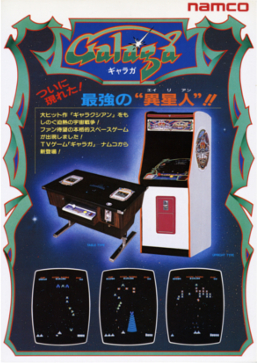
Galaga is a 1981 fixed shooter arcade video game developed and published by Namco. In North America, it was released by Midway Manufacturing. It is the sequel to Galaxian (1979), Namco's first major video game hit in arcades. Controlling a starship, the player is tasked with destroying the Galaga forces in each stage while avoiding enemies and projectiles. Some enemies can capture a player's ship via a tractor beam, which can be rescued to transform the player into a "dual fighter" with additional firepower.

Dig Dug is a maze arcade video game developed by Namco in 1981 and released in 1982, distributed in North America by Atari, Inc. The player controls Dig Dug to defeat all enemies per stage, by either inflating them to bursting or crushing them underneath rocks.

Pac-Man Vs. is a 2003 maze video game developed by Nintendo and published by Namco for the GameCube. In the game, one player takes control of Pac-Man, who must eat all of the pellets in the maze, while the others control the ghosts to try to catch them. The objective is to be the first to reach a set number of points, selected before the game begins. The player controlling Pac-Man uses the Game Boy Advance to play, while the others use the television to control the ghosts. The game requires the GameCube - Game Boy Advance link cable in order to play.

Pac-Land is a 1984 side-scrolling arcade platform game developed and released by Namco. It was distributed in North America by Bally Midway, and in Europe by Atari Games. Controlling Pac-Man, the player must make it to the end of each stage to return a lost fairy back to its home in Fairyland. Pac-Man will need to avoid obstacles, such as falling logs and water-spewing fire hydrants, alongside his enemies, the Ghost Gang. Eating large flashing Power Pellets will cause the ghosts to turn blue, allowing Pac-Man to eat them for points.

Super Pac-Man is a 1982 maze chase arcade game developed and published by Namco. It was distributed in North America by Midway, and is Namco's take on a sequel to the original Pac-Man; Midway had previously released Ms. Pac-Man, which Namco had little involvement with. Toru Iwatani returns as designer.

Pac-Man World 2 is a video game by Namco USA for the Xbox, GameCube, and PlayStation 2, released in 2002. A version of the game for Microsoft Windows was released in 2004, and an isometric sidescroller was made for the Game Boy Advance in 2005. The game is a sequel to Pac-Man World (1999). The game is a platform game, where the player controls Pac-Man in a 3D platforming environment, through six worlds. In 2005, a sequel, Pac-Man World 3, was released.

Klonoa is a platform video game series created by Namco in 1997. It stars Klonoa, an anthropomorphic creature who explores dream worlds. The series includes two main games: Klonoa: Door to Phantomile (1997) for the PlayStation and Klonoa 2: Lunatea's Veil (2001) for the PlayStation 2. A remake of Door to Phantomile was released for the Wii in 2008, and remasters of both games were released in 2022. The series also includes a set of handheld games released between 1999 and 2002 for the WonderSwan and Game Boy Advance.

Pac-Attack, also known as Pac-Panic, is a 1993 falling-tile puzzle video game developed and published by Namco for the Super Nintendo Entertainment System and Sega Genesis. Versions for the Game Boy, Game Gear and Philips CD-i were also released. The player is tasked with clearing out blocks and ghosts without them stacking to the top of the playfield — blocks can be cleared by matching them in horizontal rows, while ghosts can be cleared by placing down a Pac-Man piece that can eat them. It is the first game in the Pac-Man series to be released exclusively for home platforms.
Namco Museum is a series of video game compilations developed and published by Bandai Namco Entertainment for home video game consoles. The first title in the series, Namco Museum Vol. 1, was released for the PlayStation in 1995. Entries in the series have been released for multiple platforms, including the Game Boy Advance, PlayStation 2, PlayStation Portable, Nintendo DS and Xbox 360. the latest being Namco Museum Archives Vol. 2, released in 2020.
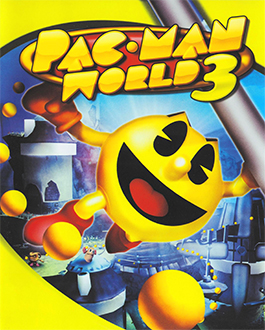
Pac-Man World 3 is a platform video game developed by Blitz Games and published by Namco for the PlayStation 2, GameCube, Xbox, PlayStation Portable, Nintendo DS, and Microsoft Windows. The Nintendo DS version was ported by Human Soft. Released in 2005, it is the third and final installment in the Pac-Man World trilogy and the only one to not be released in Japan. It also features a speaking Pac-Man for the first time ever outside of the cartoon series.

Pac & Pal is a 1983 maze chase arcade game developed and published by Namco. It is part of the company's Pac-Man series and the third to have been produced in-house. Players control Pac-Man as he must eat the items in an enclosed maze while avoiding four colored ghosts that pursue him. Pac-Man is assisted by a green-colored creature named Miru, the titular "Pal", who brings the items back to the center box. Pac-Man can also collect power-ups that allow him to briefly stun the ghosts.
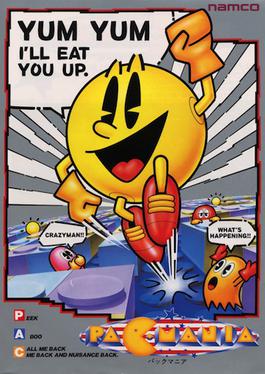
Pac-Mania is a cavalier perspective maze game that was developed and released by Namco for arcades in 1987. In the game, the player controls Pac-Man as he must eat all of the dots while avoiding the colored ghosts that chase him in the maze. Eating large flashing "Power Pellets" will allow Pac-Man to eat the ghosts for bonus points, which lasts for a short period of time. A new feature to this game allows Pac-Man to jump over the ghosts to evade capture. It is the ninth title in the Pac-Man video game series and was the last one developed for arcades up until the release of Pac-Man Arrangement in 1996. Development was directed by Pac-Man creator Toru Iwatani. It was licensed to Atari Games for release in North America.

Pac-Man Championship Edition is a 2007 maze video game developed and published by Namco Bandai Games for the Xbox 360. It has since appeared on several other platforms, including iOS, Android, and the PlayStation 3 and PlayStation Portable as a PSP mini title available on the PlayStation Store. It is an HD reimagining of the original Pac-Man arcade game; players navigate Pac-Man through an enclosed maze, eating pellets and avoiding four ghosts that pursue him. Clearing an entire side of the maze of dots will cause a fruit item to appear, and eating it will cause a new maze to appear on the opposite side.

Galaga Legions is a 2008 twin-stick shooter video game developed and released by Namco Bandai Games for the Xbox 360. It is the twelfth game in the Galaxian series, and the third developed for home platforms. The player controls a starship, the AEf-7 "Blowneedle", in its efforts to wipe out the Galaga armada. The objective of the game is to clear each of the five stages as quick as possible. Stages have a heavy emphasis on puzzle solving and chain reactions, which are necessary to clear out enemy formations. The Blowneedle has a pair of satellites at its disposal, and can place them anywhere on the screen to fend off enemies.
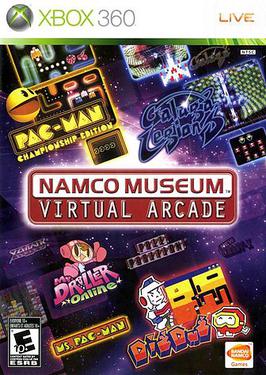
Namco Museum Virtual Arcade is a video game compilation developed and published by Namco Bandai Games for the Xbox 360. It was released in North America in 2008 and in Europe and Japan in 2009. Part of its Namco Museum series, Virtual Arcade includes 34 titles; nine of these are Namco Bandai-published Xbox Live Arcade games, and the rest are arcade games that are only accessible through the disc. Players can access the Xbox Live Arcade games through their dashboard if the disc is in the console.
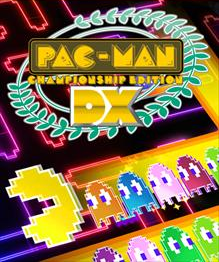
Pac-Man Championship Edition DX is a 2010 maze video game published by Namco Bandai Games for the Xbox 360 and PlayStation 3, later ported to Steam and iOS. It is the sequel to the 2007 game Pac-Man Championship Edition, which was the last game developed by series creator Toru Iwatani. The player controls Pac-Man as he must eat all of the dots in the maze while avoiding colored ghosts that pursue him. A bonus item will appear once the player has eaten all dots on one side of the maze, causing the layout to change. Several additions were made over the original, such as bombs that send all ghosts to the regeneration box and sleeping ghosts that will give chase when Pac-Man moves past them.

Namco Generations was a brand name created by Namco Bandai Games for modernized remakes of their older video games. It was introduced in 2010 in conjunction with Pac-Man Championship Edition DX for the Xbox 360 and PlayStation 3. Galaga Legions DX was the second game to use the brand, being released in 2011. Two other games were in production under the Namco Generations label, a Metro-Cross sequel named Aero-Cross and a remaster of Dancing Eyes, both of which were cancelled.

Aero-Cross is an unreleased platform video game that was in development for the PlayStation 3 and Xbox 360 by Namco Bandai Games. It was intended as a modernized sequel to the arcade game Metro-Cross, and the third released under the Namco Generations series of video game remakes. Players control a runner through each level in an effort to get to the end stage goal before the timer runs out. Levels feature hazards that must be overcome, and there are also power-ups that grant player with different abilities, such as a speed boost or being able to glide over the level.





















